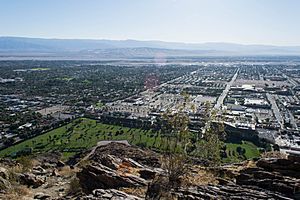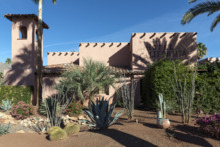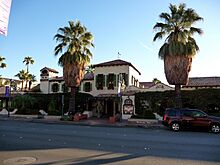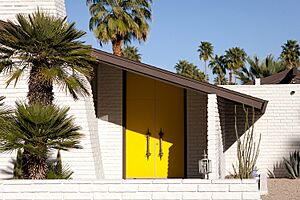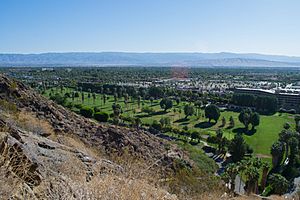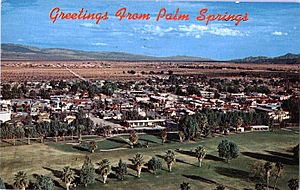Palm Springs, California facts for kids
Quick facts for kids
Palm Springs
|
|||
|---|---|---|---|
|
|||

Location within Riverside County
|
|||
| Country | United States | ||
| State | California | ||
| County | Riverside | ||
| Native American Reservation (partial) | Agua Caliente Band of Cahuilla Indians | ||
| Incorporated | April 20, 1938 | ||
| Government | |||
| • Type | Council-Manager | ||
| Area | |||
| • Total | 94.68 sq mi (245.21 km2) | ||
| • Land | 94.54 sq mi (244.85 km2) | ||
| • Water | 0.14 sq mi (0.36 km2) 0.90% | ||
| Elevation | 479 ft (146 m) | ||
| Population
(2020)
|
|||
| • Total | 44,575 | ||
| • Density | 513.21/sq mi (198.15/km2) | ||
| Time zone | UTC−8 (Pacific) | ||
| • Summer (DST) | UTC−7 (PDT) | ||
| ZIP Codes |
92262–92264
|
||
| Area codes | 442/760 | ||
| FIPS code | 06-55254 | ||
| GNIS feature IDs | 1652768, 2411357 | ||
Palm Springs is a fun desert city in Riverside County, California. It's located in the Coachella Valley, which is part of the Colorado Desert. The city is quite large, covering about 94 square miles.
A special part of Palm Springs is that more than 10% of its land belongs to the Agua Caliente Band of Cahuilla Indians. This land is part of their reservation. Palm Springs is also the main city for the largest Native American reservation in California.
In 2020, about 44,575 people lived in Palm Springs. However, many people visit or live there only in winter. This is because it's a popular place for retirement and for "snowbirds." Snowbirds are people who move from colder places to warmer places during winter. Because of this, the city's population can triple between November and March!
Palm Springs is famous for its unique mid-century modern buildings. It also has a lively arts and culture scene. Plus, there are many fun activities to do outdoors.
History of Palm Springs
How Palm Springs Began
Early History of the Cahuilla People
The first people to live in the Palm Springs area were the Cahuilla people. They arrived about 2,000 years ago. The Cahuilla lived here peacefully for hundreds of years. They spoke a language called Ivilyuat.
Many important Cahuilla leaders came from this area. One famous leader was Chief Juan Antonio. The Cahuilla often stayed in Palm Canyon during winter. In summer, they moved to cooler Chino Canyon.
The Cahuilla Indians had several permanent homes in the canyons of Palm Springs. This was because there was plenty of water and shade. They used the natural hot springs in winter. The men hunted animals like rabbits, mountain goats, and quail. They also caught fish in nearby lakes and rivers. Women gathered berries, acorns, and seeds. They even made tortillas from mesquite seeds.
You can still see ancient rock carvings, called petroglyphs, in Tahquitz, Chino, and Indian Canyons. You can also find their old irrigation ditches, dams, and house pits. In Andreas Canyon, there are pictographs (rock paintings) and mortar holes. These holes were used to grind acorns into meal.
The Agua Caliente ("Hot Water") Reservation was created in 1876. It covers about 31,128 acres. About 6,700 acres are right in Downtown Palm Springs. This Native American land is often leased out for long periods. Because it's next to fancy communities, the tribe is one of the wealthiest in California.
The Cahuilla people first called this place "Se-Khi," meaning "boiling water." In 1876, the U.S. government set up the Agua Caliente Reservation. The reservation land was divided into a "checkerboard pattern." This meant that every other square mile (640 acres) belonged to the tribe. The other squares were given to the Southern Pacific Railroad. This was to encourage them to build train lines through the desert.
Many streets in Palm Springs are named after important Native American families. These include Andreas, Arenas, Amado, Belardo, Lugo, Patencio, Saturnino, and Chino. These are all common Cahuilla family names.
Today, the Agua Caliente Band of Cahuilla Indians includes several smaller groups. They live in the Coachella Valley and San Gorgonio Pass. The Agua Caliente Reservation covers 32,000 acres. About 6,700 acres are inside Palm Springs city limits. This makes the Agua Caliente people the city's biggest landowners. In 2010, there were 410 tribal members.
Mexican Explorers Arrive
In 1821, Mexico became free from Spain. In 1823, Mexican explorer José María Estudillo and Captain José Romero were looking for a new route. They were trying to find a way from Sonora to Alta California. During their trip, they were the first to write about the "Agua Caliente" hot springs in Palm Springs. After the Mexican–American War and the Treaty of Guadalupe Hidalgo in 1848, this area became part of the United States.
Later 1800s and Early Settlers
One idea for the name "Palm" comes from early Spanish explorers. They might have called the area La Palma de la Mano de Dios, meaning "The Palm of God's hand." The name "Palm Springs" first appeared on U.S. maps in 1853. When "palm" is in a California place name, it usually refers to the native California fan palm. These trees, called Washingtonia filifera, are common in Palm Springs. Other early names for the area were "Palmetto Spring" and "Big Palm Springs."
The first European to live in Palm Springs was Jack Summers. He ran a stagecoach station on the Bradshaw Trail in 1862. In 1876, the Southern Pacific Railroad built tracks about 6 miles north. This left the stagecoach station isolated. By 1885, a lawyer named John Guthrie McCallum started buying land in Palm Springs. The name "Palm Springs" was already widely used. McCallum and his partners named the area "Palm Valley" when they started the "Palm Valley Land and Water Company."
Land Development and Drought
McCallum brought his sick son to Palm Springs for the dry climate. He worked with Dr. Oliver Wozencroft and engineer J. P. Lippincott. They built a canal from the Whitewater River. This canal brought water to fruit orchards on McCallum's land. He also asked Dr. Welwood Murray to build a hotel across from his home. Murray opened his hotel in 1886. In 1893, heavy rains flooded the crops and irrigation systems. Then, a long drought from 1894 to 1905 caused even more damage.
Palm Springs in the 1900s
Becoming a Resort Town
Palm Springs became a popular resort in the early 1900s. People who needed dry heat for their health came to visit. However, because of the extreme summer heat, the population dropped a lot in those months. In 1906, writer George Wharton James described Palm Springs as very charming. He noted that Palm Springs had a comfortable microclimate. This was because Mount San Jacinto to the west blocked cold winds in winter.
Early famous visitors included John Muir and his daughters, and U.S. Vice President Charles Fairbanks. Murray's hotel closed in 1909.
Nellie N. Coffman and her husband, Harry, opened The Desert Inn in 1909. It was a hotel and a place for people to get well. It grew into a modern hotel by 1927. Nellie Coffman was a key person in the city's tourism until she passed away in 1950.
In 1924, Pearl McCallum (Judge McCallum's daughter) built the Oasis Hotel. This hotel had a 40-foot tower. The next big hotel was the El Mirador, which opened in 1927. It was a large, fancy resort that attracted many movie stars. It had a tall, 68-foot Renaissance-style tower. Silent film star Fritzi Ridgeway built her 100-room Hotel del Tahquitz in 1929.
Golf became popular with courses like O'Donnell (1926) and El Mirador (1929). Hollywood movie stars loved the hot, dry, sunny weather and privacy. They built homes in areas like Warm Sands and The Mesa. About 20,000 visitors came to Palm Springs in 1922.
In the 1930s, Palm Springs became even more popular with movie stars. They built more homes in neighborhoods like Movie Colony and Las Palmas. Actors Charles Farrell and Ralph Bellamy opened the Racquet Club in 1934. Pearl McCallum opened the Tennis Club in 1937. Nightclubs also opened, like The Dunes (1934) and the Chi Chi nightclub (1936).
Shopping in Palm Springs
In 1930, Bullock's, a large department store from Los Angeles, opened a "resort store" in the Desert Inn. In 1947, Bullock's opened a full department store on Palm Canyon Drive. Another big L.A. store, J. W. Robinson's, then took over the old Bullock's spot.
Southern California's first self-contained shopping center was La Plaza in Palm Springs. It opened in 1936. It had a small Desmond's department store. Its three-level parking garage for 141 cars was very new for the time. In the mid-1900s, downtown Palm Springs had many department stores. These included Bullock's, J. W. Robinson's, and Saks Fifth Avenue. This made it a big shopping area. In 1967, the Desert Fashion Plaza mall was built. For two decades, downtown Palm Springs had seven department stores. There was also the Palm Springs Mall nearby.
World War II and Palm Springs
When the United States joined World War II, Palm Springs and the Coachella Valley played an important role. The local airfield became a training area for the Air Corps Ferrying Command in 1941. A new airfield, Palm Springs Army Airfield, was finished in early 1942. Soldiers trained there for ferrying aircraft.
The El Mirador Hotel was very busy before the war. After the war began, the U.S. government bought the hotel. They turned it into the Torney General Hospital. Italian prisoners of war helped in the kitchen and as orderlies. The hospital had 1,500 staff and treated about 19,000 patients.
General Patton's Desert Training Center covered the whole region. Its main base was Camp Young.
After World War II

After the war, modern architects became very popular. They designed unique vacation homes for celebrities. These homes used new building ideas and materials. For example, some had steel frames or glass walls.
In 1946, Richard Neutra designed the Kaufmann Desert House. This famous modern house used lots of glass. It had the newest technology in building materials. It used natural light and open spaces. Today, many classic buildings in Palm Springs are being protected.
Palm Springs architecture became a model for suburban homes, especially in the Southwest. This "Desert Modern" style had open floor plans, air conditioning, and large windows. It blended indoor and outdoor living. This style made homes feel like a vacation spot.
Section 14 Changes
Section 14 is a square mile of land owned by the Agua Caliente Band of Cahuilla Indians. It is very close to downtown. Before the 1960s, many people, mostly Black and other people of color, lived there. They rented land for short periods from individual Native American owners. Because leases were short, big businesses didn't want to build there.
In 1959, new laws allowed longer leases. City officials, including Mayor Frank Bogert, encouraged ending the short leases. They wanted to create long-term leases for new developments. The city used money to clear the land. This included burning down "shacks and makeshift homes." These homes had been rented for a low price. In 2021, the California Attorney General's office called this displacement a "city-engineered holocaust." It caused many Black and Latino families to lose their homes and future wealth.
After these residents were moved out, the tribe built the Spa Hotel and Casino downtown. The city also built the Palm Springs Convention Center. The tribe leased land for new hotels and condos.
In 2021, the Palm Springs City Council apologized for the evictions. They ordered a statue of Mayor Bogert to be removed. The statue was moved in 2022. Former residents of Section 14 are still seeking money for what happened.
Year-Round Living
Palm Springs stayed popular with Hollywood stars, retirees, and Canadian tourists. Between 1947 and 1965, the Alexander Construction Company built about 2,200 houses. This doubled the number of homes in Palm Springs.
By the 1970s, more retirees moved to the Coachella Valley. Palm Springs began to change from a quiet summer town to a year-round community. Businesses and hotels that used to close in summer stayed open. As more businesses grew, more families with children moved there.
The 1973–75 recession affected Palm Springs. Wealthy residents had to spend less money. Later in the 1970s, some Chicago mobsters invested a lot of money in the area. They bought houses, land, and businesses. Even with competition from other desert cities, Palm Springs has continued to do well.
During the COVID-19 pandemic, Palm Springs became a popular place to live. Many people moved from bigger cities like Los Angeles and San Francisco. They wanted less crowded areas where they could work from home.
Spring Break Fun
Since the early 1950s, Palm Springs has been a popular place for spring break. The 1963 movie Palm Springs Weekend made it even more famous. More and more college students visited. Sometimes, the large crowds caused problems. In the 1980s, over 10,000 students would visit. In 1990, residents complained about the parties. Mayor Sonny Bono and the city council closed Palm Canyon Drive to spring breakers. This caused downtown businesses to lose money.
Palm Springs Today
Tourism is a very important part of Palm Springs' economy. In 2011, 1.6 million people visited the city. Palm Springs has over 130 hotels and resorts. It also has many bed and breakfasts and over 100 restaurants. Events like the Coachella and Stagecoach Festivals in nearby Indio attract younger people. This makes the greater Palm Springs area an appealing place to live.
After the 2008 recession, Palm Springs started to improve its downtown area. New construction and renovations began.
In 2020, Christy Holstege became the mayor of Palm Springs. She was the first openly bisexual mayor in the United States. She was also the first female mayor of Palm Springs. The next year, Lisa Middleton became mayor. She was the first openly transgender mayor in California history.
Palm Springs is known for its mid-century modern architecture. This style was popular in the 1950s and 60s. Many people want to protect these classic buildings and homes. Stores in the city sell furniture and gifts with a mid-century modern look. The city holds a Modernism Week celebration every February. This event features films, talks, and tours of these special buildings.
Geography of Palm Springs
Palm Springs is located in the Sonoran Desert. The city covers about 95 square miles. Most of this is land, with a small amount of water. Palm Springs is in the Coachella Valley desert region. It is surrounded by mountains. The San Bernardino Mountains are to the north. The Santa Rosa Mountains are to the south. The San Jacinto Mountains are to the west. And the Little San Bernardino Mountains are to the east.
Climate of Palm Springs
Palm Springs has a hot desert climate. This means it's very hot and dry. It gets over 300 days of sunshine each year. It only receives about 4.93 inches of rain annually. The wettest year on record was from July 1926 to June 1927, with 17.68 inches of rain. The driest year was from July 2001 to June 2002, with only 0.40 inches.
Winters are warm, with most days reaching 70°F. In January and February, afternoons often reach 80°F. Sometimes, temperatures can even go over 90°F. On average, there are 17 mornings a year where temperatures drop to or below 40°F. Freezing temperatures happen in less than half of all years. The lowest temperature ever recorded was 19°F on January 22, 1937.
Summers are extremely hot. Daytime temperatures are usually above 110°F. Overnight temperatures often stay above 80°F. The average yearly temperature is 75.6°F. On average, there are 176.6 afternoons that reach 90°F or higher. Temperatures of 100°F or higher happen on 114.8 afternoons. The highest temperature ever recorded in Palm Springs was 124°F on July 5, 2024. The climate is good for some palm trees, but tropical ones that need more water don't grow as well.
On October 1, 2024, the temperature in Palm Springs reached 117°F. This tied the record for the highest October temperature in the United States. The same temperature was reached in nearby Mecca on October 5, 1917.
Wildlife in Palm Springs
The animals in Palm Springs are mostly those that can live in the desert. They are used to very hot and cold temperatures and little water. Some native animals include pronghorns, desert bighorn sheep, desert tortoise, and kit fox. You might also see desert iguanas, horned lizards, chuckwalla, bobcats, and mountain lions. Other animals include ground squirrels, rock squirrels, porcupines, skunks, and raccoons.
Desert birds include the famous roadrunner. This bird can run faster than 15 miles per hour! Other birds are the ladder-backed woodpecker, elf owls, and great horned owls. There are also many types of raptors.
The Sonoran Desert has more types of rattlesnakes (11) than anywhere else. The Mojave green is very venomous and considered the most dangerous. The largest rattlesnake here is the western diamondback rattlesnake. Other types include the black-tailed rattlesnake and sidewinder rattler. Palm Springs is also home to tarantulas and different kinds of scorpions.
While black bears are not common in the Coachella Valley, they have been seen in Palm Springs. Jaguars used to live throughout the Coachella Valley. The last time a jaguar was seen in Palm Springs was in 1860.
Neighborhoods of Palm Springs
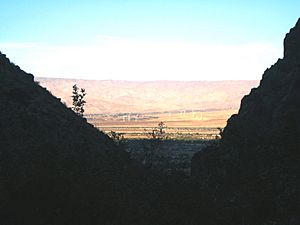
Palm Springs has a program to identify its unique neighborhoods. Out of 45 neighborhoods, 7 are known for their history and culture.
Movie Colony Neighborhoods
The Movie Colony is just east of Palm Canyon Drive. The Movie Colony East neighborhood goes even further east. These areas started growing in the 1930s. Hollywood movie stars built smaller vacation homes here. Famous people like Bob Hope, Frank Sinatra, Estée Lauder, and Bing Crosby had homes in these neighborhoods.
El Rancho Vista Estates
In the 1960s, Robert Fey built 70 homes in El Rancho Vista Estates. These homes were designed by Donald Wexler and Ric Harrison. Famous residents included Jack LaLanne.
Warm Sands
Historic homes in Warm Sands date back to the 1920s. Many were built from adobe. This area also has small resorts.
The Mesa
The Mesa started as a gated community in the 1920s. It was near the Indian Canyons. Famous residents included King Gillette, Zane Grey, Clark Gable, and Suzanne Somers. Unique homes here include Donald Wexler's "butterfly houses."
Tahquitz River Estates
Some homes in this neighborhood are from the 1930s. Pearl McCallum McManus owned this area. She started building homes here after World War II. Dr. William Scholl (from Dr. Scholl's foot products) owned a 10-acre estate here. Today, this is the largest neighborhood organization with 600 homes and businesses.
Sunmor Estates
During World War II, the original Sunmor Estates was part of the Palm Springs Army Airfield. Robert Higgins and the Alexander Construction Company built homes here. Actor and former mayor Frank Bogert lived in his home here for over 50 years.
Historic Tennis Club
Artist Carl Eytel built his cabin on what became the Tennis Club in 1937. Another artist, Gordon Coutts, built his Moroccan-style "Dar Marrac" estate in 1924. Other famous places include the Casa Cody Inn and the Ingleside Inn. The neighborhood now has about 400 homes, condos, and restaurants.
Las Palmas Neighborhoods
To the west of Palm Canyon Drive are the Vista Las Palmas, Old Las Palmas, and Little Tuscany neighborhoods. These areas also have unique homes and celebrity estates. Albert Frey's private homes, called Villa Hermosa, are also here.
Racquet Club Estates
Historic Racquet Club Estates is north of Vista Chino. It has over 500 mid-century modern homes built by the Alexander Construction Company. "Meiselman" homes and the famous Donald Wexler steel homes are also here. Racquet Club Estates was Palm Springs' first middle-income neighborhood. It became popular with Hollywood's elite in the 1950s and 60s.
Deepwell Estates
Deepwell Estates has about 370 homes. It includes many architecturally important homes and celebrity houses. Some celebrities who lived here include Jerry Lewis, Loretta Young, and Liberace.
Demographics
Population in 2010
| Historical population | |||
|---|---|---|---|
| Census | Pop. | %± | |
| 1940 | 3,434 | — | |
| 1950 | 7,660 | 123.1% | |
| 1960 | 13,468 | 75.8% | |
| 1970 | 20,936 | 55.4% | |
| 1980 | 32,359 | 54.6% | |
| 1990 | 40,181 | 24.2% | |
| 2000 | 42,807 | 6.5% | |
| 2010 | 44,552 | 4.1% | |
| 2020 | 44,575 | 0.1% | |
| U.S. Decennial Census | |||
In 2010, Palm Springs had a population of 44,552 people. The city had about 469 people per square mile. Most residents (75.7%) were White. About 4.4% were African American, and 4.4% were Asian. About 25.3% of the people were Hispanic or Latino.
There were 22,746 households in Palm Springs. About 14.7% of these households had children under 18. About 25.6% were married couples. Many households (44.0%) were made up of individuals living alone. About 18.9% of these were people aged 65 or older. The average household had 1.93 people.
The population was spread out by age. About 13.7% were under 18. About 26.5% were 65 or older. The average age was 51.6 years. For every 100 females, there were 129.3 males.
In 2009-2013, the average household income in Palm Springs was $45,198. About 18.2% of the population lived below the poverty line.
Population in 2000
In 2000, there were 42,807 people living in Palm Springs. There were 20,516 households. The population density was about 454 people per square mile. Most residents (78.3%) were White. About 3.9% were African American, and 3.8% were Asian. About 23.7% of the population was Hispanic or Latino.
About 16.3% of households had children under 18. About 34.0% were married couples. Many households (41.6%) were individuals living alone. About 18.3% of these were people aged 65 or older. The average household size was 2.1 people.
The population was spread out by age. About 17.0% were under 18. About 26.2% were 65 or older. The average age was 47 years. For every 100 females, there were 107.8 males.
The average household income in 2000 was $35,973. About 15.1% of the population lived below the poverty line.
Economy
Even though celebrities still visit Palm Springs, many now live in other parts of the Coachella Valley. The city's economy mostly depends on tourism. Local government gets a lot of its money from sales taxes and hotel taxes. Palm Springs hosts many festivals, conferences, and international events. One big event is the Palm Springs International Film Festival.
You can find the world's largest rotating cable cars at the Palm Springs Aerial Tramway. These cars go up 2.5 miles from Chino Canyon to a station at 8,516 feet. From the top, you can explore the San Jacinto Wilderness. There's also a restaurant with amazing views.
The Palm Springs Convention Center was expanded and renovated. Many hotels, restaurants, and attractions cater to tourists. Shoppers can find many fancy stores in downtown and uptown Palm Springs. Downtown shopping is centered around historic La Plaza, built in 1936.
Top Employers
Here are the top employers in Palm Springs, based on a 2022 report:
| No. | Employer | No. of Employees |
|---|---|---|
| 1 | Palm Springs Unified School District | 2,584 |
| 2 | Desert Regional Medical Center | 2,459 |
| 3 | Agua Caliente Casino Palm Springs | 547 |
| 4 | City of Palm Springs | 470 |
| 5 | Walmart Supercenter | 387 |
| 6 | Margaritaville Resort Palm Springs | 251 |
| 7 | The Home Depot | 220 |
| 8 | Lowe's Home Improvement | 152 |
| 9 | Ace Hotel & Swim Club | 114 |
| 10 | Hilton Palm Springs Resorts | 108 |
Arts and Culture
Yearly Cultural Events
- The Palm Springs International Film Festival and Palm Springs International Festival of Short Films ("ShortFest") are big movie events. They happen in January and June.
- Modernism Week is an 11-day event in February. It celebrates mid-century modern architecture with films, talks, and tours.
- The Palm Springs Black History Committee celebrates Black History Month every February. They have a parade and a town fair.
- The Agua Caliente Cultural Museum hosts its yearly Festival of Native Film & Culture.
- The Club Skirts Dinah Shore Weekend, known as "The Dinah," is a large event held each March.
- A "White Party" is held in April, attracting 10,000 visitors.
- The Palm Springs Cultural Center hosts several events. These include Cinema Diverse: The Palm Springs LGBTQ Film Festival.
- Palm Springs Desert Resorts Restaurant Week happens every June. Over 100 restaurants in the Coachella Valley offer special dining.
- The Caballeros, a gay men's chorus, has performed concerts since 1999.
Former Mayor Will Kleindienst created these three parades on Palm Canyon Drive:
- The Palm Springs Annual Homecoming Parade is held before the Palm Springs High School Homecoming Game.
- The city hosts a Veterans Day parade, concert, and fireworks display. It's one of the official national Veterans Day sites.
- The Palm Springs Festival of Lights Parade is held on the first Saturday of December.
Ongoing Cultural Events
For many years, The Fabulous Palm Springs Follies was a stage show. It was at the historic Plaza Theatre. It featured performers over 55 years old. The Follies closed after the 2013–14 season.
Since 2004, the city has had a weekly Palm Springs VillageFest. This downtown street fair happens every Thursday evening. Tourists and locals enjoy walking among the food and craft vendors on Palm Canyon Drive.
The Desert Film Society sponsors events about films and filmmaking.
Public Art
The city and other groups have supported different public art projects. These include Robolights. Many art galleries and studios are in the city. The California Art Club has a chapter in Palm Springs. The Desert Art Center of Coachella Valley started in Palm Springs in 1950.
Modern Architecture

Palm Springs is famous for its mid-century modern architecture. Many well-known architects have designed buildings here. Other architects (not just mid-century modern) include Edward H. Fickett and Howard Lapham.
Museums and Other Places to Visit
- Agua Caliente Band of Cahuilla Indians
- Agua Caliente Cultural Museum (located downtown)
- Indian Canyons (Palm Canyon, Andreas Canyon, Murray Canyon)
- Tahquitz Canyon, a wildlife area.
- Tahquitz Falls, a 60-foot waterfall. It was used in the 1937 film, Lost Horizon.
- Agua Caliente Casino in Rancho Mirage.
- Spa Resort Casino, built on the town's original hot springs.
- Forever Marilyn sculpture by Seward Johnson in downtown Palm Springs.
- Moorten Botanical Garden and Cactarium
- Palm Springs Historical Society Museums (and Village Green)
- Miss Cornelia White's "Little House" (built with railroad ties)
- The McCallum Adobe – the oldest building, built in 1884.
- Ruddy's General Store Museum – a 1930s general store.
- Palm Springs Air Museum – located at the Palm Springs International Airport.
- Palm Springs Art Museum – originally called the Desert Museum.
- Annenberg Theater
- Palm Springs Walk of Stars
- San Jacinto Mountains
- Cactus to Clouds Trail – leads from the Art Museum to San Jacinto Peak.
- Mount San Jacinto State Park
- Palm Springs Aerial Tramway
- Santa Rosa and San Jacinto Mountains National Monument
- Children's Discovery Museum of the Desert – in Rancho Mirage.
- Living Desert Zoo and Gardens – in Palm Desert, California.
- Joshua Tree National Park
Some popular restaurants include 1501 Uptown Gastropub, Chi Chi, and Sherman's Deli & Bakery.
Sports
Baseball in Palm Springs
Palm Springs is home to the Palm Springs Power. This is a summer baseball team for college players. They play in the California Premier Collegiate League. The Power also run the California Winter League. This league helps professional baseball players show their skills. Games are played in January and February at Palm Springs Stadium.
Palm Springs Stadium used to be the spring training site for the California Angels baseball team. This was from 1961 to 1993. Other teams like the Chicago White Sox and Oakland A's also trained there.
Hockey in Palm Springs
In 2019, Palm Springs was approved for a new hockey team. This team would be part of the American Hockey League (AHL). It would be a development team for the National Hockey League's Seattle Kraken. However, plans to build an arena in Palm Springs fell through. So, the team's launch was delayed. The team, now called the Coachella Valley Firebirds, is building its arena in nearby Thousand Palms, California.
Tennis in Palm Springs
The Palm Springs area hosts many major sports events. One is the annual BNP Paribas Open in March. Professional players have voted it the top tournament of the year many times. The Easter Bowl is another important tournament. It's for junior tennis players (ages 12 to 18) and happens every March.
Golf in Palm Springs
The Coachella Valley has more golf courses than any other region in California. It's the most popular golf vacation spot in the state. Early golf courses in Palm Springs were the O'Donnell Golf Club and the El Mirador Hotel course. Both opened in the 1920s.
The first 18-hole golf course in the area was the Thunderbird Country Club. It opened in 1951 in Rancho Mirage. In 1955, it hosted the 11th Ryder Cup championship.
By the 1970s, the area had over 40 courses. In 2001, the 100th course opened. The area also hosts big golf tournaments like the PGA Tour's Humana Challenge.
Soccer in Palm Springs
The Palm Springs AYSO Region 80 is part of the American Youth Soccer Organization.
Parks and Recreation
City Parks
- City parks include:
- Baristo Park
- DeMuth Park
- Desert Healthcare (Wellness) Park
- Downtown Park
- James O. Jessie Desert Highland Unity Center
- Dog Park (behind city hall)
- Frances Stevens Park
- Ruth Hardy Park
- Sunrise Park
- Victoria Park
Recreation Activities
- Boomers! is a fun family center in Cathedral City.
- CNL Financial Group runs the Wet'n'Wild Palm Springs water park in the summer.
In 1931, the Desert Riders group was formed. It started as a social club for people in Palm Springs. Now, the group supports horseback riding and building trails for riders, hikers, and bikers. The Desert Riders also offered chuckwagon meals and rides through canyons to hotel guests. This helped Palm Springs grow its tourism.
Education
Public Schools
Public education in Palm Springs is managed by the Palm Springs Unified School District. Palm Springs High School is the oldest school in the district. It was built in 1938.
Elementary schools in Palm Springs include:
- Cahuilla Elementary School
- Cielo Vista Charter School (received a U.S. Department of Education National Blue Ribbon award in 2011)
- Katherine Finchy Elementary School (received a U.S. Department of Education National Blue Ribbon award in 2011)
- Vista del Monte Elementary School
The Ramon Alternative Center offers different types of education.
Private Schools
Private schools in Palm Springs and nearby areas include Desert Chapel Christian School (K-12), Desert Adventist Academy (K–8), and Sacred Heart School (PreK-8).
In 2006, the Roman Catholic Diocese of San Bernardino built the Xavier College Preparatory High School in Palm Desert.
Colleges and Universities
The main campus for the Desert Community College District is College of the Desert in Palm Desert. California State University, San Bernardino and University of California, Riverside used to have small campuses there. Now, they have their own buildings in Palm Desert.
Private colleges include Brandman University (in Palm Desert) and Kaplan College (Palm Springs).
Media
Radio and Television
Palm Springs is a unique TV market. It's entirely within a small part of Riverside County. Palm Springs didn't have its own local TV station until 1968. Before that, people watched TV stations from Los Angeles.
TV stations serving Palm Springs and the Coachella Valley include:
Other networks like The CW and PBS are also available through low-power TV stations.
Palm Springs also has many AM and FM radio stations.
News and Magazines
- The Desert Sun is the local daily newspaper. It covers Palm Springs and the Coachella Valley.
- The Palm Springs Post is a digital news site just for Palm Springs.
- Desert Magazine is a monthly magazine about lifestyle.
- The Desert Star Weekly is published in Desert Hot Springs, California.
- The Desert Daily Guide is a weekly magazine for the LGBT community.
- Palm Springs Life is a monthly magazine. It covers shopping, entertainment, homes, health, and golf.
Infrastructure
Libraries
The city's library started in 1924. It was funded by Martha Hitchcock. It expanded in 1940 on land given by Dr. Welwood Murray. The current site is a branch library and a research library for the Palm Springs Historical Society. It also serves as a tourism office.
Transportation
One of the first ways to travel to Palm Springs was on the Bradshaw Trail. This was a historic stagecoach route from San Bernardino to La Paz, Arizona. It operated from 1862 to 1877. In the 1870s, the Southern Pacific Railroad built tracks into the Coachella Valley.
Modern transportation services include:
- Palm Springs International Airport serves Palm Springs and the Coachella Valley. During World War II, it was called the Palm Springs Army Airfield.
- SunLine Transit Agency provides bus service in the Coachella Valley.
- Morongo Basin Transit Authority provides bus service to and from Morongo Basin communities.
- Amtrak's Sunset Limited and Texas Eagle trains stop three times a week at the Palm Springs Amtrak station.
- Amtrak Thruway buses connect Palm Springs to other cities.
- Greyhound Bus Lines has a stop at the Palm Springs Amtrak station.
- Flixbus offers bus service to other places in Southern California and Arizona.
Major highways include:
 SR 111 – California State Route 111 goes through the city.
SR 111 – California State Route 111 goes through the city. I-10 – Interstate 10 is generally north of the city.
I-10 – Interstate 10 is generally north of the city. SR 74 – The Pines to Palms Scenic Byway (California State Route 74) goes from the coast, over the San Jacinto Mountains, to nearby Palm Desert.
SR 74 – The Pines to Palms Scenic Byway (California State Route 74) goes from the coast, over the San Jacinto Mountains, to nearby Palm Desert. SR 62 – California State Route 62 connects to I-10 northwest of the city. It goes northeast to Joshua Tree.
SR 62 – California State Route 62 connects to I-10 northwest of the city. It goes northeast to Joshua Tree.
Cemeteries
In 1890, the Jane Augustine Patencio Cemetery was created. It is maintained by the Agua Caliente Tribe.
The Welwood Murray Cemetery was started by hotel owner Welwood Murray in 1894. It is maintained by the Palm Springs Cemetery District. This district also maintains the Desert Memorial Park in Cathedral City.
Also in Cathedral City is the Forest Lawn Cemetery.
Notable People
Over 400 people from Palm Springs and the Coachella Valley have been honored on the Palm Springs Walk of Stars.
See also
 In Spanish: Palm Springs para niños
In Spanish: Palm Springs para niños














